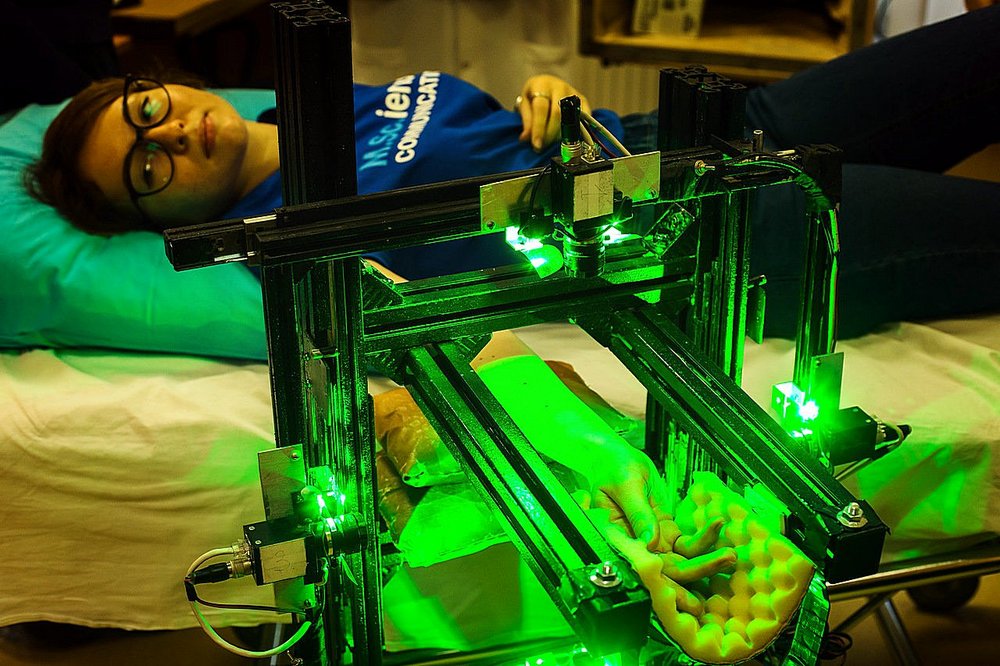A research team from ITMO University and Almazov Centre proposed a new non-contact method for measuring blood flow in the upper limbs. The method is based on video recording of the skin surface under green light measuring the absorption of red blood cells. This helps see how effective the circulatory system and the blood flow regulation are. The experimental results showed that the proposed method is as accurate as the traditional one. However, it is easier to use, cheaper and suitable for more patients. The research was published in Biomedical Optics Express.
Measuring blood flow in the limbs is an important diagnostic indicator. By studying how efficient is the heart in supplying blood to the limbs, we can see whether the cardiovascular system works properly, and evaluate parameters of the blood flow regulation. Today, contact (tensiometric) methods of occlusive plethysmography are used to measure blood flow in the limbs. As a rule, they are based on the registration of changes in the volume or diameter of the limb by filling with blood during venous occlusion.
Occlusion is a way to affect the blood flow when a small pressure on the arm stops venous outflow without disturbing the arterial blood flow. Eventually, it is possible to calculate the blood flow by the increase in the limb volume due to the flow of blood from the heart. However, contact measurement systems can be difficult to configure and use. Besides, contact methods are expensive and require adaptation for each patient.
To overcome the limitations of standard methods, scientists from ITMO University and Almazov Centre have developed a non-contact system for measuring blood flow in the upper limbs. It is based on photoplethysmography. This technique is capable of tracking changes in blood filling of the skin by video recording of green light absorption. When the green light hits a red blood cell, the reflected wave changes its polarization. The camera registers only this altered signal and tracks when it gets most intense. The reason for the increase in light absorption during venous occlusion can be explained by the increase in the number of red blood cells, most likely due to the expansion of small veins in the upper layer of the skin.

To assess the accuracy of measurements with the new system, scientists conducted a series of experiments and compared the values obtained by traditional and new methods. Experimental measurements were performed on healthy volunteers. The signal was recorded during several cycles of venous occlusion. The results of the evaluation of cold stress effect on the functioning of vessels obtained by the new method almost completely coincided with the results of traditional measurements.
“In this research, we used four cameras for non-contact measurements to ensure the registration of the signal from all sides of the hand. This would allow us to detect the heterogeneity of the signal, if it occurs due to the difference in the work of the capillaries in different parts of the skin. We developed special software, ordered and assembled the equipment necessary to synchronize and process the data flow simultaneously from four cameras. But in the course of the study, we saw that the difference was not that great, which means that in the future measurements can be carried out with only one camera,” comments Alexey Kamshilin, specialist of the International Scientific and Technical Centre (Computational Optics, Photonics and Image Visualization) of ITMO University.
The proposed method does not directly measure the total musculocutaneous blood flow. However, the research confirmed that the measurement of skin blood flow is subject to the same regulatory effects as the general blood flow in the limb. The proposed contactless method is as accurate as the traditional one, but it is cheaper, easier to use, suitable for most patients and can be applied not only to the upper but also to the lower limbs without additional optimization. Now, scientists are working to adapt the proposed method for the legs.
The researchers found that by registering a change in the absorption of green colour by the skin during the venous occlusion, it is possible to determine the state of blood flow in its upper layers. Changing the conditions of the experiment influences the tone of blood vessels and affects the speed of the blood flow. This allows assessing the vascular resistance regulation by the nervous system and other control mechanisms. Such changes are observed in a number of diseases associated with damage to nerves and blood vessels.
“Our ultimate goal is to create an easy-to-use medical device to assess the blood flow in both upper and lower limbs as the registration of blood flow disorders in the legs has an important additional diagnostic potential. Thus, in diabetes, complications most often affect the skin of the lower limbs. There is even such a thing as “diabetic foot”. The new technique will be of interest to both endocrinologists and vascular surgeons who are engaged in the treatment of varicose veins of the lower limbs, as well as the restoration of blood flow in patients with arterial atherosclerosis. At the same time, many changes in the regulation can be detected early enough for effective prevention and treatment,” notes Oleg Mamontov, researcher of the Research Laboratory for Circulatory Physiology at Almazov Centre.
